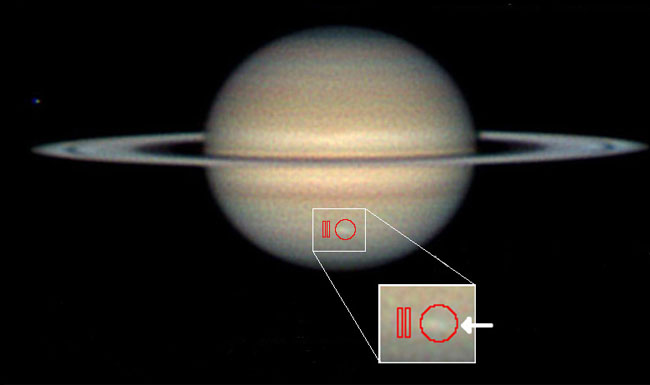Giant Blizzard Raging on Saturn

A massive blizzard is raging on Saturn — a storm so largeand fierce NASA astronomers and amateur skywatchers can see it from Earth.
NASA's Cassini spacecraft currently orbiting Saturn has afront row seat to the otherworldly tempest and is recording the most detaileddata yet of storms on the ringed planet. But amateur astronomers back on Earthhave also managed to chip in on the Saturn blizzard stormwatch.
"We were so excited to get a heads-up from theamateurs," said Cassini scientist Gordon Bjoraker, a composite infraredspectrometer team member based at NASA's Goddard Space Flight Center inGreenbelt, Md. ?
The data showed a large, turbulent storm, dredging up a lotof material from the deep atmosphere and covering an area at least five timeslarger than the biggest blizzard that hit Earth so far this year — the"Snowmageddon" storm that blanketed the Washington, D.C. area in snowin February. [Saturn'srings and moons.]
Saturn's 'storm alley'
Cassini's radio and plasma waveinstrument and imaging cameras have been tracking thunder and lightningstorms on Saturn for years in a region around Saturn's mid-latitudes thatis nicknamed "storm alley."
But, gathering data on storms requires a tricky balancingact, since storms on Saturn can come and go on a time scale of weeks, whileCassini's imaging and spectrometer observations have to be locked in placemonths in advance.
Breaking space news, the latest updates on rocket launches, skywatching events and more!
Given these limitations, NASA sometimes enlists the help ofamateur astronomers.
The radio and plasma wave instrument regularly picks upelectrostatic discharges that are associated with the storms, so scientistshave been sending periodic tips to amateurs, who can quickly go to theirbackyard telescopes and try to spy the bright convective storm clouds.
Amateur astronomers Anthony Wesley, Trevor Barry andChristopher Go received one of those notices in February, and were able to snapdozens of pictures over the next several weeks.
In fact, in late March, Wesley — who is based in Australiaand was the first person spot the aftermath of an cometimpact on Jupiter last summer — sent Cassini scientists an e-mailwith a picture of the storm attached.
"I wanted to be sure that images like these were beingseen by the Cassini team just in case this was something of interest to beimaged directly by Cassini or the Hubble Space Telescope," Wesley wrote.
Cassini scientists analyzed all the images in detail,including a picture from March 13 of the storm at its peak, taken by Go, wholives in the Philippines.
Saturn's storm season
Luckily, the composite infrared spectrometer happened to betargeting the latitude of the storms. The Cassini scientists had known theremight be storms in that area, but were unsure when they might be active.
The Cassini spectrometer obtained data on March 25 and 26that showed larger than expected amounts of phosphine, a gas typically found inSaturn's deep atmosphere, and an indicator that powerful currents were liftingmaterial upward into the upper troposphere.
The spectrometer data also showed that the tropopause, whichis the dividing line between the serene stratosphere and the lower churningtroposphere, was about 1 degree Fahrenheit (minus 17.2 degrees Celsius) colderin the storm cell than in neighboring areas.
"A balloonist floating about 100 kilometers (62 miles)down from the bottom of Saturn's calm stratosphere would experience anammonia-ice blizzard with the intensity of Snowmageddon," said BrigetteHesman, a composite infrared spectrometer team member and assistant researchscientist at the University of Maryland.
"These blizzards appear to be powered by violentstorms deeper down — perhaps another 100 to 200 kilometers (62 to 124miles) down — where lightning has been observed and the clouds are made of waterand ammonia," Hesman said.
The Cassini-Huygens mission is a joint project of NASA, theEuropean Space Agency and the Italian Space Agency. The composite infraredspectrometer team is based at NASA's Goddard Space Flight Center in Greenbelt,Md.
- TheWildest Weather in the Galaxy
- TheRings and Moons of Saturn
- Top10 Extreme Planet Facts

Space.com is the premier source of space exploration, innovation and astronomy news, chronicling (and celebrating) humanity's ongoing expansion across the final frontier. Originally founded in 1999, Space.com is, and always has been, the passion of writers and editors who are space fans and also trained journalists. Our current news team consists of Editor-in-Chief Tariq Malik; Editor Hanneke Weitering, Senior Space Writer Mike Wall; Senior Writer Meghan Bartels; Senior Writer Chelsea Gohd, Senior Writer Tereza Pultarova and Staff Writer Alexander Cox, focusing on e-commerce. Senior Producer Steve Spaleta oversees our space videos, with Diana Whitcroft as our Social Media Editor.
